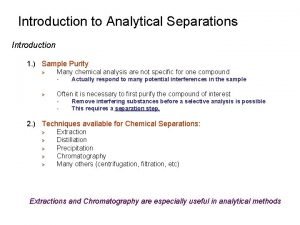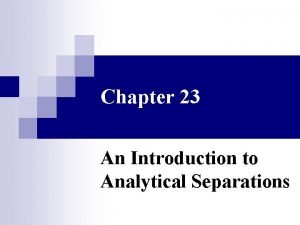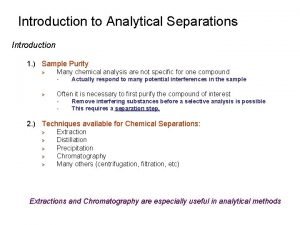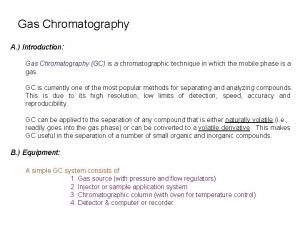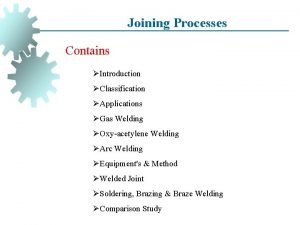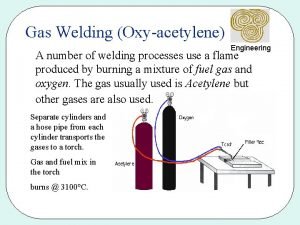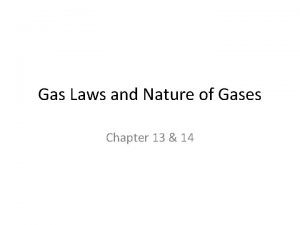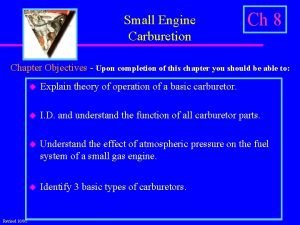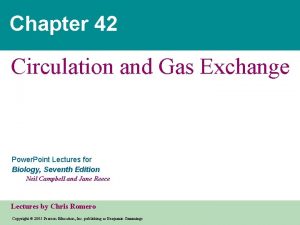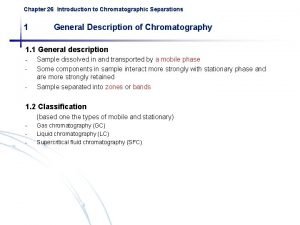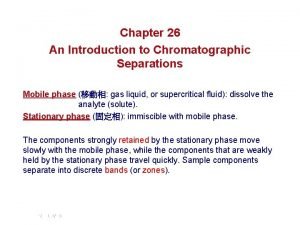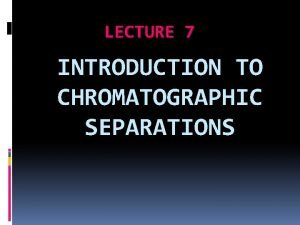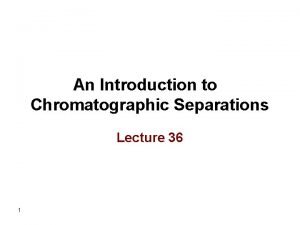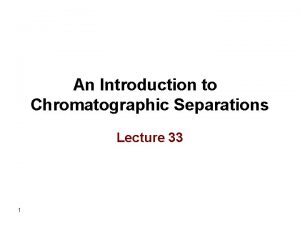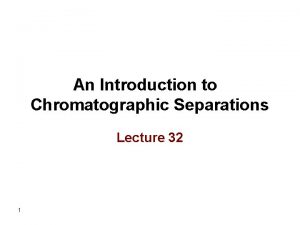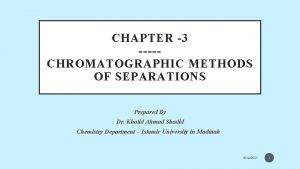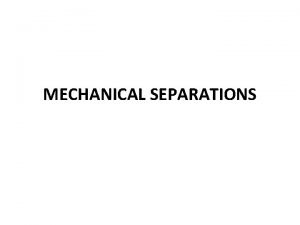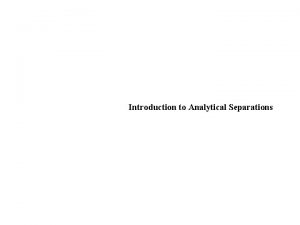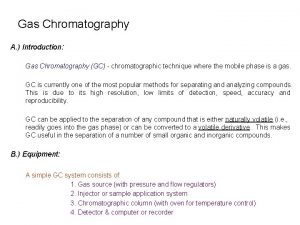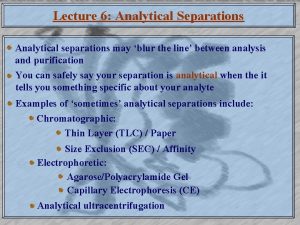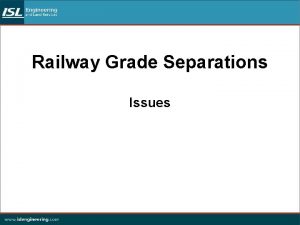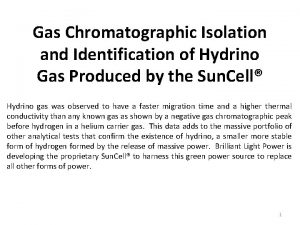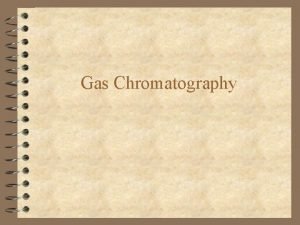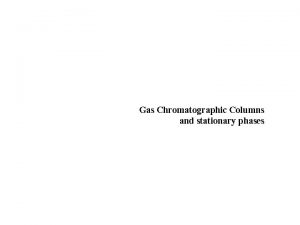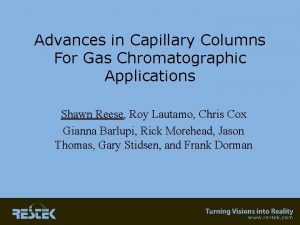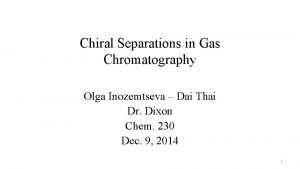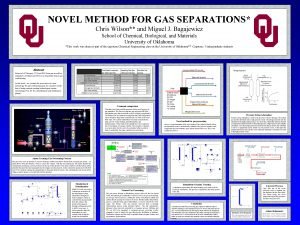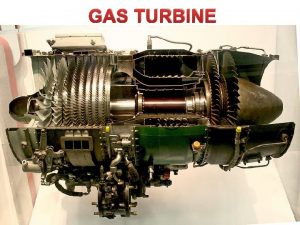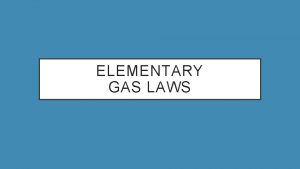Chapter 26 An Introduction to Chromatographic Separations Gas































- Slides: 31

Chapter 26 An Introduction to Chromatographic Separations Gas Chromatography

26 A General Description of Chromatography 26 A-1 Classification of Chromatographic Methods Two ways: Column Chromatography Planar Chromatography a) Liquid chromatography --- Liquid - liquid (LLC) --- Liquid - solid (LSC) --- Liquid - bonded phase (LSB) --- Ion - exchange (IEC) --- Gel - permeation (GPC)

b) Gas chromatography --- Gas - liquid (GLC) --- Gas - solid (GSC) --- Gas - bonded phase c) Supercritical-fluid chromatography d) Electrochromatography


26 A-2 Elution in Column Chromatography Fig. 26 -1 Elution Chromatography Fig. 26 -2 Concentration profiles of analyte band A and B

26 B Migration Rates of Solutes Fig. 26 -3 Improving separation

26 B-1 Distribution Constants Amobile ⇄ Astationary 26 B-2 Retention time t R, t M The average linear rate of solute migration:

26 B-3 The Relationship between Volumetric Flow Rate and Linear Flow Velocity The average linear rate of molecules of the mobile phase: Fig. 26 -4

26 B-4 The Relationship between Retention Time and Distribution Constant = u x fraction of time solute spends in mobile phase = u x moles of solute in mobile phase / total moles of solute

26 B-5 The Rate of Solute Migration: The Retention Factor

26 B-6 Relative Migration Rates: The Selectivity Factor. from

26 C Band Broadening and Column Efficiency N = L/H, 1) Plate height, 2) Plate count plate

Fig. 26 -6



Fig. 26 -8 Effect of mobile-phase flow rate on plate height for LC and GC


The Longitudinal Diffusion Term (Fig. 26 -9)

The Stationary-Phase Mass-Transfer Term The Mobile Phase Mass-Transfer Term H = A + B/u + (CS + CM)u A Van Deemter plot (Fig. 26 -10)

Fig. 26 -11 Effect of particle size

26 D Optimization of Column Performance 26 D-1 Column Resolution (Rs)

26 D-2 The Effect of Retention and Selectivity Factors on Resolution

26 D-3 The Effect of Resolution on Retention Time

Example 26 -1 a) b) c)

d) e) f)

29 D-4 Variables That Affect Column Performance Variation in Retention Factor Variation in Selectivity Factor

Fig. 26 -13 Effect of retention factor k. B on resolution and elution time

26 D-5 The General Elution Problem Fig. 26 -14 Effect of solvent variation on chromatograms

Fig. 26 -15


 Partition chromatography
Partition chromatography Immiscible
Immiscible Adjusted retention time
Adjusted retention time Usaf first sergeant afi
Usaf first sergeant afi Derive ideal gas equation
Derive ideal gas equation Imaginary gas
Imaginary gas Differences between ideal gas and real gas
Differences between ideal gas and real gas Ideal gas vs perfect gas
Ideal gas vs perfect gas Conclusion for bhopal gas tragedy
Conclusion for bhopal gas tragedy Gas leaked in bhopal gas tragedy
Gas leaked in bhopal gas tragedy Gas reale e gas ideale
Gas reale e gas ideale Flue gas desulfurisation gas filter
Flue gas desulfurisation gas filter Poisonous gas leaked in bhopal gas tragedy
Poisonous gas leaked in bhopal gas tragedy Difference between ideal gas and real gas
Difference between ideal gas and real gas Contoh soal kinetika kimia orde 1
Contoh soal kinetika kimia orde 1 Gas exchange key events in gas exchange
Gas exchange key events in gas exchange [email protected]
[email protected] Gas welding introduction
Gas welding introduction Introduction of gas turbine
Introduction of gas turbine Gas chromatography
Gas chromatography Oxy acetylene flame definition
Oxy acetylene flame definition Introduction of gas welding
Introduction of gas welding Single u butt joint
Single u butt joint Soldering torch in orthodontics
Soldering torch in orthodontics Boyle's law variables
Boyle's law variables Chapter 8 carburetion answers
Chapter 8 carburetion answers Chapter 42 circulation and gas exchange
Chapter 42 circulation and gas exchange Introduction paragraph format
Introduction paragraph format Chapter 3 lesson 1 introduction to global systems
Chapter 3 lesson 1 introduction to global systems Introduction to operation management
Introduction to operation management Introduction to management science solution
Introduction to management science solution Chapter 52 an introduction to ecology and the biosphere
Chapter 52 an introduction to ecology and the biosphere
